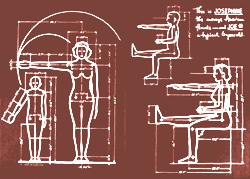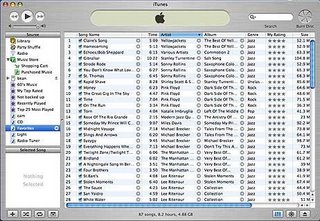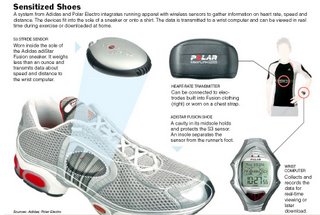 The link below looks at three professional designers who happen to be African-American.
The link below looks at three professional designers who happen to be African-American.POH Article Summary
This blog is intended to serve as a repository for issues related to Design and a forum for this designer to share his perspective on the factors that have and are shaping the profession. . . Contact: myroncurtissmith@hotmail.com
 The link below looks at three professional designers who happen to be African-American.
The link below looks at three professional designers who happen to be African-American. A great project for a introductory design class would be to have the students consider ways of improving the toilet paper holder.
A great project for a introductory design class would be to have the students consider ways of improving the toilet paper holder. This past year I was so impressed by the presentation on concrete at the National Building Musuem (DC) that I am now a devotee of the substance. Not only was the content well organized but the exhibtion space and graphics were all done well.
This past year I was so impressed by the presentation on concrete at the National Building Musuem (DC) that I am now a devotee of the substance. Not only was the content well organized but the exhibtion space and graphics were all done well.
 In addressing the functional needs of women's undergarments (i.e. comfort, apperance, fit...) through new materials and manufacturing techinques has resulted in a noticeable bump in sales among brands producing these products.
In addressing the functional needs of women's undergarments (i.e. comfort, apperance, fit...) through new materials and manufacturing techinques has resulted in a noticeable bump in sales among brands producing these products. Story Behind WNBA Uniforms
Story Behind WNBA Uniforms
 Ross Lovegrove Interview
Ross Lovegrove Interview Envisioning Information
Envisioning Information (The Bauhaus masters from the left: Josef Albers, Hinnerk Scheper, Georg Muche, László Moholy-Nagy, Herbert Bayer, Joost Schmidt, Walter Gropius, Marcel Breuer, Vassily Kandinsky, Paul Klee, Lyonel Feininger, Gunta Stölzl and Oskar Schlemme)
(The Bauhaus masters from the left: Josef Albers, Hinnerk Scheper, Georg Muche, László Moholy-Nagy, Herbert Bayer, Joost Schmidt, Walter Gropius, Marcel Breuer, Vassily Kandinsky, Paul Klee, Lyonel Feininger, Gunta Stölzl and Oskar Schlemme) The power of the grid is its ability to bring order to the composition of a page.
The power of the grid is its ability to bring order to the composition of a page. NYT Article on CCTV
NYT Article on CCTV

 Metaphors have been used successfully in the development of the computer's Graphical User Interface (GUI). A desktop metaphor used to describe common office tasks is sketched on the napkin at the left.
Metaphors have been used successfully in the development of the computer's Graphical User Interface (GUI). A desktop metaphor used to describe common office tasks is sketched on the napkin at the left. 
 Herman Miller, the company that created the cubicle and the Aeron chair, has long been admired for its innovation and quality. Herman Miller, Inc., based in Zeeland, Michigan, began in 1923 as a manufacturer of residential furniture. Over the years, the company has become a leader in design and manufacture of modern furniture for both home and office.
Herman Miller, the company that created the cubicle and the Aeron chair, has long been admired for its innovation and quality. Herman Miller, Inc., based in Zeeland, Michigan, began in 1923 as a manufacturer of residential furniture. Over the years, the company has become a leader in design and manufacture of modern furniture for both home and office.  Industrial designer, Henry Dreyfuss, 1904-1972, opened his design office in 1929 to design products for corporate America. That same year, he won a prestigious design competition for creating "the phone of the future," a tabletop version that included transmitter and receiver in the same handset - a revolutionary concept for its time.
Industrial designer, Henry Dreyfuss, 1904-1972, opened his design office in 1929 to design products for corporate America. That same year, he won a prestigious design competition for creating "the phone of the future," a tabletop version that included transmitter and receiver in the same handset - a revolutionary concept for its time.  IDSA Biography
IDSA Biography


 Hence, iTunes, Apples digital music service has provided the competitive advantage that allowed the iPod to capture 70% of the market and provide a key barrier to entry from other digital music players.
Hence, iTunes, Apples digital music service has provided the competitive advantage that allowed the iPod to capture 70% of the market and provide a key barrier to entry from other digital music players. 
 Identifying a growing market opportunity and having a good concept is not a substitute for understanding the motivations of the consumer.
Identifying a growing market opportunity and having a good concept is not a substitute for understanding the motivations of the consumer.  Design programs in America must take stock of the potential impact of design policy initiatives of nation's intent on participating in the growing international marketplace. China alone has made plans to educate thousands of designers each year to support its developing markets.
Design programs in America must take stock of the potential impact of design policy initiatives of nation's intent on participating in the growing international marketplace. China alone has made plans to educate thousands of designers each year to support its developing markets.
 "Paul Rand's stature as one of the world's leading graphic designers is incontestable. For half a century his pioneering work in the field of advertising design and typography has exerted a profound influence on the design profession; he almost single-handedly transformed "commercial art" from a practice that catered to the lowest common denominator of taste to one that could assert its place among the other fine arts."
"Paul Rand's stature as one of the world's leading graphic designers is incontestable. For half a century his pioneering work in the field of advertising design and typography has exerted a profound influence on the design profession; he almost single-handedly transformed "commercial art" from a practice that catered to the lowest common denominator of taste to one that could assert its place among the other fine arts."


 I discovered that beyond its looks the Vtech phone offers some useful features, and some not so useful ones, which set it apart other phones. For starters, the form of the unit gives it an appearance of sophistication and a polished modernism. Its use of cutting edge digital spectrum technology reduces interference and blocks ease dropping. A built-in voice message system, speaker phone and digital phone book (that interfaces with Palm and Outlook software) are fashioned into a single footprint are all winners. Whereas the handset's small color screen that plays animations seems less useful.
I discovered that beyond its looks the Vtech phone offers some useful features, and some not so useful ones, which set it apart other phones. For starters, the form of the unit gives it an appearance of sophistication and a polished modernism. Its use of cutting edge digital spectrum technology reduces interference and blocks ease dropping. A built-in voice message system, speaker phone and digital phone book (that interfaces with Palm and Outlook software) are fashioned into a single footprint are all winners. Whereas the handset's small color screen that plays animations seems less useful.
 I recall being struck by the beauty of Macintosh's chairs during a design history course, particulairly the high back Hill house and the Willow tea room chairs. As a testimony to the lasting style of these chairs, designed a century earlier, they can still be seen in music videos and design magazines.
I recall being struck by the beauty of Macintosh's chairs during a design history course, particulairly the high back Hill house and the Willow tea room chairs. As a testimony to the lasting style of these chairs, designed a century earlier, they can still be seen in music videos and design magazines.

